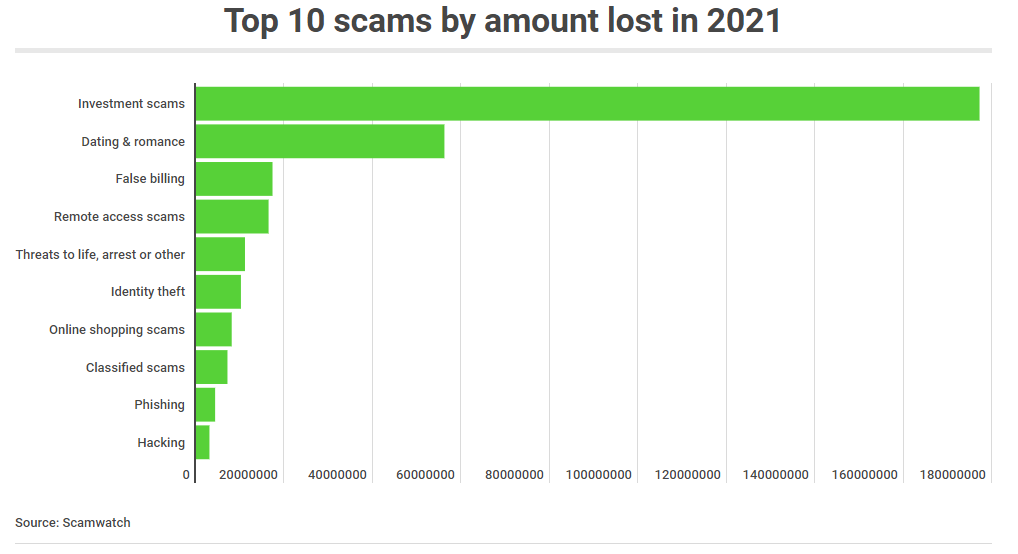The Rise of Fraud and Cybercrime

Payment providers are under pressure to ensure that customer demands for convenience don’t come at the expense of higher fraud and cybercrime.
.
Payment providers have long had to balance the trade-off between meeting mandated security requirements and providing convenience and the latest technology for consumers.
Over the past five to 10 years, this pressure has become more intense, as the demand for a wider variety of fast and convenient payment options. This, however, sometimes comes at the expense of security with criminals taking advantage of the situation.
Fraud and Scams in Australia
Australians lost a record $323 million to scams in 2021. Money lost to scams almost doubled in one year, with more than 286,000 Aussies reporting they were scammed last year.
These figures represent a ‘significant’ increase of 84% compared to 2020, when Aussies lost $175.6 million through the year.
Investment scams did the most damage according to the latest figures from the Australian Competition and Consumer Commission’s (ACCC) Scamwatch.
Investment scams accounted for $177 million, followed by dating and romance scams which saw people losing $52 million.
December saw the most money lost ($43.2 million) and August 2021 saw the highest number of scams reported (40,874).
New South Wales residents were collectively duped of $110 million – the highest, followed by Victoria where residents reported $74 million lost.
Crispin Kerr, Australia-New Zealand vice president at cybersecurity company Proofpoint, said the data paints an unfortunate picture of just how effective scammers were at taking advantage of Australians in the past year.
“The 84% increase in losses to scams in 2021 is significant and is just the tip of the iceberg when it comes to understanding the true impact on Australians,” Mr Kerr said.
“Based on the numbers for December, during the holiday season, people can become desensitised to receiving numerous advertising links for shopping deals and the like and may not think twice about opening a dangerous file or clicking a suspicious link.
“The data shows scammers were extremely active in 2021 and we anticipate this will only increase as scammers continue to evolve and update their tactics.”
How are Aussies getting scammed?
While investment and romance scams were the most damaging, there were a number of other scams that saw Aussies losing millions.
Investment scams accounted for more than half of all the money lost to scams last year, and increased in prevalence by 32% compared to 2020.
“Investment scams can seem very attractive, and scammers can come across as legitimate in their promise of financial gain through the purchase of shares, funds, cryptocurrency or other high returns,” Mr Kerr said.
“However, the reality is that these get-rich-quick schemes enable scammers to steal personal and financial information to siphon funds for their own gain.”
Social media sites were the main hub for money loss via romance and dating scams, with 40% of scams reported resulting in money lost.
“Scammers also utilised social engineering particularly during lockdowns when people were at their most vulnerable to steal millions from Australians in dating and romance scams,” Mr Kerr said.
Phishing scams – where scammers aim to gain personal information – had the highest number of reports in 2021, making up one quarter of all scams reported. This is an increase of 61% on the year prior.
Scams relating to threats to life or arrest disproportionately affected younger Australians aged 18 to 24 years old, and accounted for the highest losses at $3.3 million.
Employment and job scams also more than doubled in 2021 to $2.6 million, and identity theft scams increased threefold to $10 million.
Who is getting scammed?
Older Australians suffered the greatest loss according to the ACCC’s figures, with people over 65 years old losing a total of $81.9 million throughout the year.
This demographic also reported the highest number of scams (46,282), followed by Australians aged 35 to 4 years old with 43,526 scams reported.
Men lost more to scams than women, with men reporting $190 million lost compared to $131 million reported by women.
No age group was exempt from losing money to scams, but the amount lost to scams did increase with age in 2021.

Source: https://www.savings.com.au/news/scamwatch-2021
The risk of card-not-present transactions
When it comes to card fraud, however, card not present (CNP) transactions continue to dominate, making up 87% of total transactions. In 2019, AusPayNet launched the CNP Fraud Mitigation Framework to address and control this type of fraud.
Usually CNP fraud involves breaches by third parties, through hacking of IT systems of a retailer or other company. Stolen card details can then be stored by criminals and used well after the breach. Card on file transactions – where a customer keeps their card on file with a merchant they use regularly – are also becoming a preferred target of cybercriminals.
The good news about card fraud
Global fraud losses for card issuers, merchants and acquirers of card transactions from merchants and ATMs are large, totalling almost US$28 billion in 2018 – a huge increase from the US$7.6 billion lost back in 2010.[1]
Having said this though, in the past couple of years, the number of cases of payment fraud globally has been declining. This success has come through coordinated action within the payments industry, through measures including:
- a widespread roll out of chip and PIN (or chip and signature in the US) for card transactions at a physical point of sale (POS)
- the use of strong two-factor authentication for ‘card not present’ payments, as mandated in several countries
- improvements in fraud mitigation software, including the application of machine learning and artificial intelligence, and
- the roll out of tokenisation to protect card information held on file in databases and in mobile handsets.
The future of scams
Globally, the COVID-19 pandemic has seen a spike in scams seeking to exploit fears about the virus, which include targeting government payments and superannuation withdrawals. In Australia, just before the pandemic broke out in early 2020, there was also a spike in scam activity related to bushfire donations.
In response, governments and financial institutions are taking responsibility to educate themselves, consumers and businesses about the types of scams out there to help others avoid being exploited. They’re also doing more to identify and track account takeovers, shutting down “fake named” and “mule” accounts that scammers use to receive payments.
Predictions on fraud and scams are almost impossible to make, as criminals are always changing their methods and targets, partly to circumvent government efforts to address fraudulent activity. However, by having an action plan of “education, awareness and tracking”, governments, banks, consumers and businesses can take control to prevent themselves from being another scam statistic.
Looking ahead
As the world of payments continues to make strides forward, Australian consumers are likely to be at the forefront of the next evolution. At Indue, we help businesses adapt and meet the changing expectations of consumers, by delivering innovative, compliant and secure payment systems.
To learn more about the trends shaping the payments landscape and what it means for your business, contact us today
[1] Nilson Report, The Nilson Report Issue 1164, November 2019.

